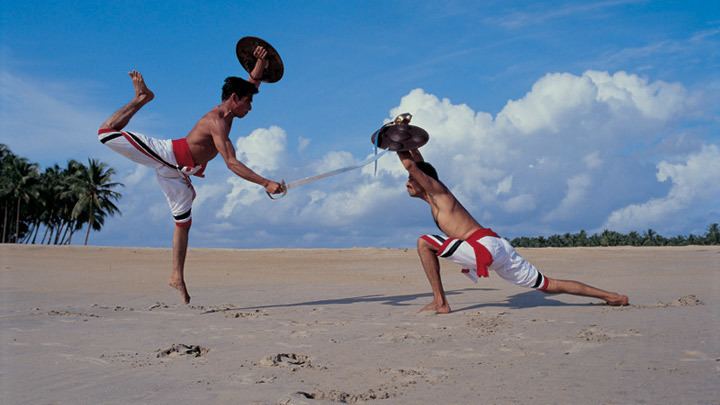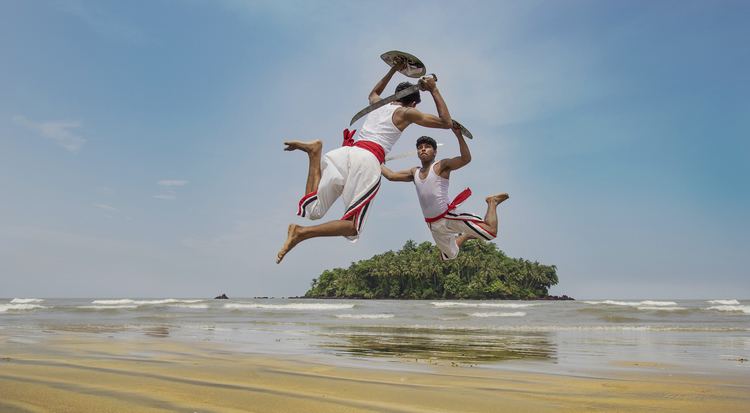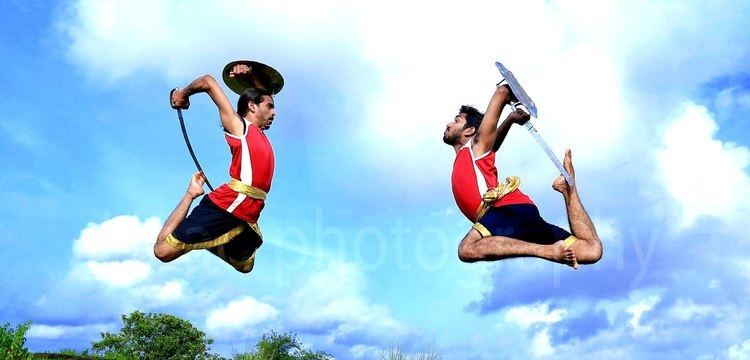Olympic sport No | Focus Freestyle | |
 | ||
Meaning "Practice in the arts of the battlefield." Hardness Full-contact, Semi-contact Weapons Sword, Urumi, Spear, Shield, Machete, Katar, Gada, Quarterstaff, Trishula, Maduvu Famous practitioners Jasmine Simhalan, Aromal Chekaver, Simhalan Madhava Panicker, Grandmaster Shifuji Shaurya | ||
Kalaripayattu (Tamil: களரி பயிற்சி Malayalam:കളരിപ്പയറ്റ്) is a martial art, which originated as a style in Kerala, southern India (North Malabar). The word kalari first appears in the Tamil Sangam literature to describe both a battlefield and combat arena. The word kalari tatt denoted a martial feat, while kalari kozhai meant a coward in war. Each warrior in the Sangam era received regular military training. It is considered to be one of the oldest fighting systems in existence. It was originally practiced in northern and central parts of Kerala and southern parts of Tamil Nadu.It is believed that from 'Vadakkan Patt' or Northern Ballads ,Chekavar , a warrior section within Thiyya community were the forefathers of kalari Currently many other Indian states also practice this martial art.
Contents
- India martial art kalaripayattu part 01
- History
- Revival
- Styles
- Northern kalaripayattu
- Southern kalaripayattu
- Central kalaripayattu
- Techniques
- Marmashastram and massage
- Weapons
- The Kalari Payattu festival and origin
- References

India martial art kalaripayattu part 01
History

Early written evidence of martial arts in Southern India dates back to the Sangam literature of about the 3rd century BC to the 2nd century AD. The Akananuru and Purananuru describe the use of spears, swords, shields, bows and silambam in the Sangam era. The word kalari appears in the Puram (verses 225, 237, 245, 356) and Akam (verses 34, 231, 293) to describe both a battlefield and combat arena. The word kalari tatt denoted a martial feat, while kalari kozhai meant a coward in war. Each warrior in the Sangam era received regular military training in target practice, horse and elephant riding. They specialized in one or more of the important weapons of the period including the spear (vel), sword (val), shield (kedaham), and bow and arrow (vil ambu). The combat techniques of the Sangam period were the earliest precursors to kalaripayat. References to "Silappadikkaram" in Sangam literature date back to the 2nd century. This referred to the silambam staff which was in great demand with foreign visitors.

Elements from the Yoga Sutras of Patanjali, as well as finger movements in the nata dances, were incorporated into the fighting arts. A number of South Asian fighting styles remain closely connected to yoga, dance and performing arts. Some of the choreographed sparring in kalaripayat can be applied to dance and kathakali dancers who knew kalaripayat were believed to be markedly better than other performers. Velakali an art form from the southern part of kerala combines elements of Kalaripayat to depict ancient battle scenes from the epic Mahabharata. Until recent decades, the chhau dance was performed only by martial artists. Some traditional Indian classical dance schools still incorporate martial arts as part of their exercise regimen.

Kalaripayattu had developed into its present form by the 6th century, during an extended period of warfare between the Chera and Chola dynasties. Kalaripayattu includes strikes, kicks, grappling, preset forms, weaponry and healing methods. Regional variants are classified according to geographical position in Kerala; these are the Northern style from Malabar region in north Kerala practiced by the Central style from inner Kerala and the southern style from Thiruvitankoor. Northern kalaripayattu is based on elegant and flexible movements, evasions, jumps and weapons training, while the southern "Adi Murai" style primarily follows the hard impact based techniques with priority on empty hand fighting and pressure point strikes. Both systems make use of internal and external concepts. Some of the flexibility training methods in northern Kalaripayattu are applied in Keralan dance forms and Kathakali dancers who knew martial arts were believed to be markedly better than the other performers. Some traditional Indian dance schools still incorporate kalaripayattu as part of their exercise regimen. Vedic sage Agastya is regarded as the founder and patron saint of southern kalaripayat, silambam and varmam -an ancient science of healing using varmam points for varied diseases. Along with Lord Parasurama, especially in Kerala.
The art was disseminated through schools known as kalari, which served as centres of learning before the modern educational system was introduced. Still in existence, kalaris served as meeting places for the acquisition of knowledge on various subjects ranging from mathematics, language, astronomy and various theatrical arts. More specifically, martial arts were taught in the payattu kalari, meaning fight school.
Revival
The resurgence of public interest in kalaripayattu began in the 1920s in Thalassery, as part of a wave of rediscovery of the traditional arts throughout south India and continued through the 1970s surge of general worldwide interest in martial arts. In recent years, efforts have been made to further popularise the art, with it featuring in international and Indian films such as Ondanondu Kaladalli (Kannada) (1978), Asoka (2001), The Myth (2005), The Last Legion (2007), Manasara (2010), Urumi (film) (2011), Commando (2013), Baaghi (2016), Veeram (2016 film) (2016).
Styles
Kalaripayattu has three regional variants, which are distinguished by their attacking and defensive patterns.
Northern kalaripayattu
Northern kalaripayattu (vadakkan kalari) is practised mainly in North Malabar mostly by Thiyyans & Kurups. It places more emphasis on weapons than on empty hands. Parashurama, sixth avatar of Vishnu, is believed to be the style's founder according to both oral and written tradition. Masters in this system are usually known as gurukkal or occasionally as asan, and were often given honorific titles, especially Panikkar. The northern Brahmin immigrants contributed their skills through the "Salai"s which were educational institutions imparting various branches of knowledge including military arts. Chekavar , a warrior section within Thiyya caste are the forefathers of Kalari. They are known as 'Pathinettu Kalirikkum Chekon' meaning those who are the masters of 18 Kalaris. Kurups were allowed to study only upto 17th adav in Kalari. Nairs and Thiyyas who formed the core of military units were sent to kalari gymnasiums right from the age of seven and were expected to be at the service of the sovereigns at a day's notice Other than the Nairs, the Thiyya community were experts in Kalarapayattu with some well known names like Kannara Gurukkal. The Chekavar, a warrior section within the community, were part of the militias of local chieftains and kings. There were numerous renowned kalaripayattu experts among Chekavars.
The northern style is distinguished by its meippayattu - physical training and use of full-body oil massage. The system of treatment and massage, and the assumptions about practice are closely associated with Ayurveda. The purpose of medicinal oil massage is to increase the practitioners' flexibility, to treat muscle injuries incurred during practice, or when a patient has problems related to the bone tissue, the muscles, or nerve system. The term for such massages is thirumal and the massage specifically for physical flexibility Chavutti Thirumal or Chavutti Uzhichil which literally means "stamping massage" or "foot massage". The masseur uses their feet and entire body weight to massage the person.
There are several lineages/styles (sampradayam), including arappukai, pillatanni vattantirippu and thulunadan. In olden times, students went to Tulunadu kalari's to overcome their defects (kuttam theerkkal). There are schools which teach more than one of these traditions. Some traditional kalari around Kannur for example teach a blend of arappukai, pillatanni, and katadanath styles.
History
By oral and written tradition, Parasurama (sixth avatar of Vishnu) is believed to be the northern style's founder. What eventually crystallized as northern kalaripayat combined indigenous Dravidian techniques with the martial practices and ethos brought by migrations from Saurastra and Konkan down the west Indian coast into Karnataka and eventually Kerala. Phillip B. Zarrilli, a professor at the University of Exeter and one of the few western authorities on kalaripayat, estimates that the northern style dates back to at least the 16th century A.D. The historian Elamkulam Kunjan Pillai attributes the birth of northern kalaripayat to an extended period of warfare between the Cheras and the Cholas in the 11th century AD.
Southern kalaripayattu
The Southern Kalari masters are known as asaan. The stages of training are chuvatu (solo forms), jodi (partner training/sparring), kurunthadi (short stick), neduvadi (long stick), katthi (knife), katar (dagger), valum parichayum (sword and shield), chuttuval (flexible sword), double sword, kalari grappling and marma (pressure points). The southern style, was practiced largely by the Nairs and Nadars has features distinguishing it from its other regional counterparts.
Zarrilli refers to southern kalaripayattu as varma ati (the law of hitting), marma ati (hitting the vital spots) or varma kalai (art of varma). The preliminary empty handed techniques of varma ati are known as adithada (hit/defend). Marma ati refers specifically to the application of these techniques to vital spots. Weapons include bamboo staves, short sticks, and the double deer horns.
Medical treatment in the southern styles is identified with siddha, the traditional Dravidian system of medicine distinct from north Indian ayurveda. The Siddha medical system, otherwise known as siddha vaidyam, is also attributed to Agastya.
Interest in learning Varma Kalai has budded in students of Tamil Nadu and Kerala, after the release of Indian Movie.
Central kalaripayattu
The Madhya-Kerala Kalari (central style) of kalaripayattu is practiced mainly in the Central Kerala. Its diverse distinctive techniques, with heavy emphasis on application, are performed within floor paths known as kalam.[1] The Madhya Kalari has many different styles which place heavy emphasis on lower body strength and speed through thorough practice of various chuvadu, only after which participants advance into weaponry and advanced studies.
Techniques
Kalaripayattu techniques are a combination of steps (Chuvatu) and postures (Vadivu). Chuvatu literally means ‘steps’, the basic steps of the martial arts. Vadivu literally means ‘postures’ or stances are the basic characteristics of Kalaripayattu training. Named after animals, they are usually eight in number. Styles differ considerably from one tradition to another. Not only do the names of poses differ, the masters also differ about application and interpretation. Each stance has its own style, power combination, function and effectiveness. These techniques vary from one style to another.
Marmashastram and massage
It is claimed that learned warriors can disable or kill their opponents by merely touching the correct marmam (vital point). This is taught only to the most promising and level-headed persons, to discourage misuse of the technique. Marmashastram stresses on the knowledge of marmam and is also used for marma treatment (marmachikitsa). This system of marma treatment comes under siddha vaidhyam, attributed to the sage Agastya and his disciples. Critics of kalaripayattu have pointed out that the application of marmam techniques against neutral outsiders has not always produced verifiable results.
The earliest mention of marmam is found in the Rig Veda, where Indra is said to have defeated Vritra by attacking his marman with a vajra. References to marman also found in the Atharva Veda. With numerous other scattered references to vital points in Vedic and epic sources, it is certain that India's early martial artists knew about and practiced attacking or defending vital points. Sushruta (c. 6th century BC) identified and defined 107 vital points of the human body in his Sushruta Samhita. Of these 107 points, 64 were classified as being lethal if properly struck with a fist or stick. Sushruta's work formed the basis of the medical discipline ayurveda, which was taught alongside various Indian martial arts that had an emphasis on vital points, such as varma kalai and marma adi.
As a result of learning about the human body, Indian martial artists became knowledgeable in the field of traditional medicine and massage. Kalaripayattu teachers often provide massages (uzhichil) with medicinal oils to their students in order to increase their physical flexibility or to treat muscle injuries encountered during practice. Such massages are generally termed thirumal and the unique massage given to increase flexibility is known as katcha thirumal. It is said to be as sophisticated as the uzhichil treatment of ayurveda. Kalaripayattu has borrowed extensively from Ayurveda and equally lends to it.
Weapons
Although no longer used in sparring sessions, weapons are an important part of kalaripayattu. This is especially true for the northern styles which are mostly weapon-based. Some of the weapons mentioned in medieval Sangam literature have fallen into disuse over time and are rarely taught in kalaripayattu today.
The Kalari Payattu festival and origin
A kalari is the school or training hall where martial arts are taught. They were originally constructed according to vastu sastra with the entrance facing east and the main door situated on the centre-right. Sciences like mantra saastra, tantra saastra and marma saastra are utilized to balance the space's energy level. The training area comprises a puttara (seven tiered platform) in the south-western corner. The guardian deity (usually an avatar of Bhagavathi, Kali or Shiva) is located here, and is worshiped with flowers, incense and water before each training session which is preceded by a prayer. Northern styles are practiced in special roofed pits where the floor is 3.5 feet below the ground level and made of wet red clay meant to give a cushioning effect and prevent injury. The depth of the floor protects the practitioner from winds that could hamper body temperature. Southern styles are usually practiced in the open air or in an unroofed enclosure of palm branches. Traditionally, when a kalari was closed down it would be made into a small shrine dedicated to the guardian deity.
